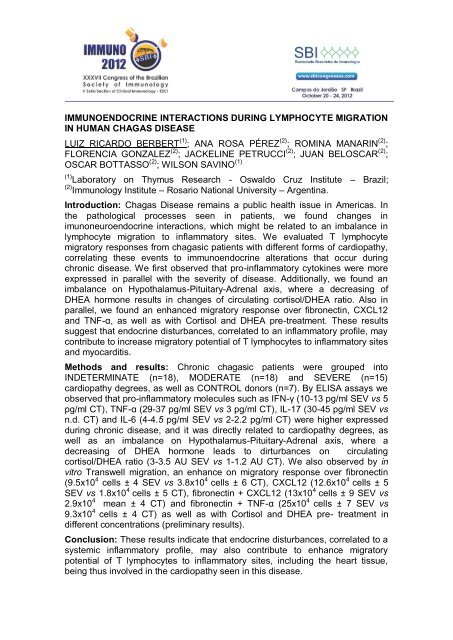immunology of infectious and parasitic diseases - XXXVII Congress ...
immunology of infectious and parasitic diseases - XXXVII Congress ...
immunology of infectious and parasitic diseases - XXXVII Congress ...
You also want an ePaper? Increase the reach of your titles
YUMPU automatically turns print PDFs into web optimized ePapers that Google loves.
IMMUNOENDOCRINE INTERACTIONS DURING LYMPHOCYTE MIGRATION<br />
IN HUMAN CHAGAS DISEASE<br />
LUIZ RICARDO BERBERT (1) ; ANA ROSA PÉREZ (2) ; ROMINA MANARIN (2) ;<br />
FLORENCIA GONZALEZ (2) ; JACKELINE PETRUCCI (2) ; JUAN BELOSCAR (2) ;<br />
OSCAR BOTTASSO (2) ; WILSON SAVINO (1)<br />
(1) Laboratory on Thymus Research - Oswaldo Cruz Institute – Brazil;<br />
(2) Immunology Institute – Rosario National University – Argentina.<br />
Introduction: Chagas Disease remains a public health issue in Americas. In<br />
the pathological processes seen in patients, we found changes in<br />
imunoneuroendocrine interactions, which might be related to an imbalance in<br />
lymphocyte migration to inflammatory sites. We evaluated T lymphocyte<br />
migratory responses from chagasic patients with different forms <strong>of</strong> cardiopathy,<br />
correlating these events to immunoendocrine alterations that occur during<br />
chronic disease. We first observed that pro-inflammatory cytokines were more<br />
expressed in parallel with the severity <strong>of</strong> disease. Additionally, we found an<br />
imbalance on Hypothalamus-Pituitary-Adrenal axis, where a decreasing <strong>of</strong><br />
DHEA hormone results in changes <strong>of</strong> circulating cortisol/DHEA ratio. Also in<br />
parallel, we found an enhanced migratory response over fibronectin, CXCL12<br />
<strong>and</strong> TNF-α, as well as with Cortisol <strong>and</strong> DHEA pre-treatment. These results<br />
suggest that endocrine disturbances, correlated to an inflammatory pr<strong>of</strong>ile, may<br />
contribute to increase migratory potential <strong>of</strong> T lymphocytes to inflammatory sites<br />
<strong>and</strong> myocarditis.<br />
Methods <strong>and</strong> results: Chronic chagasic patients were grouped into<br />
INDETERMINATE (n=18), MODERATE (n=18) <strong>and</strong> SEVERE (n=15)<br />
cardiopathy degrees, as well as CONTROL donors (n=7). By ELISA assays we<br />
observed that pro-inflammatory molecules such as IFN-γ (10-13 pg/ml SEV vs 5<br />
pg/ml CT), TNF-α (29-37 pg/ml SEV vs 3 pg/ml CT), IL-17 (30-45 pg/ml SEV vs<br />
n.d. CT) <strong>and</strong> IL-6 (4-4.5 pg/ml SEV vs 2-2.2 pg/ml CT) were higher expressed<br />
during chronic disease, <strong>and</strong> it was directly related to cardiopathy degrees, as<br />
well as an imbalance on Hypothalamus-Pituitary-Adrenal axis, where a<br />
decreasing <strong>of</strong> DHEA hormone leads to dirturbances on circulating<br />
cortisol/DHEA ratio (3-3.5 AU SEV vs 1-1.2 AU CT). We also observed by in<br />
vitro Transwell migration, an enhance on migratory response over fibronectin<br />
(9.5x10 4 cells ± 4 SEV vs 3.8x10 4 cells ± 6 CT), CXCL12 (12.6x10 4 cells ± 5<br />
SEV vs 1.8x10 4 cells ± 5 CT), fibronectin + CXCL12 (13x10 4 cells ± 9 SEV vs<br />
2.9x10 4 mean ± 4 CT) <strong>and</strong> fibronectin + TNF-α (25x10 4 cells ± 7 SEV vs<br />
9.3x10 4 cells ± 4 CT) as well as with Cortisol <strong>and</strong> DHEA pre- treatment in<br />
different concentrations (preliminary results).<br />
Conclusion: These results indicate that endocrine disturbances, correlated to a<br />
systemic inflammatory pr<strong>of</strong>ile, may also contribute to enhance migratory<br />
potential <strong>of</strong> T lymphocytes to inflammatory sites, including the heart tissue,<br />
being thus involved in the cardiopathy seen in this disease.



